Operad
In mathematics, an operad is concerned with prototypical algebras that model properties such as commutativity or anticommutativity as well as various amounts of associativity. Operads generalize the various associativity properties already observed in algebras and coalgebras such as Lie algebras or Poisson algebras by modeling computational trees within the algebra. Algebras are to operads as group representations are to groups. An operad can be seen as a set of operations, each one having a fixed finite number of inputs (arguments) and one output, which can be composed one with others. They form a category-theoretic analog of universal algebra.
History
Operads originate in algebraic topology from the study of iterated loop spaces by J. Michael Boardman and Rainer M. Vogt,[1][2] and J. Peter May.[3] The word "operad" was created by May as a portmanteau of "operations" and "monad" (and also because his mother was an opera singer).[4] Interest in operads was considerably renewed in the early 90s when, based on early insights of Maxim Kontsevich, Victor Ginzburg and Mikhail Kapranov discovered that some duality phenomena in rational homotopy theory could be explained using Koszul duality of operads.[5][6] Operads have since found many applications, such as in deformation quantization of Poisson manifolds, the Deligne conjecture,[7] or graph homology in the work of Maxim Kontsevich and Thomas Willwacher.
Definition
Non-symmetric operad
A non-symmetric operad (sometimes called an operad without permutations, or a non- or plain operad) consists of the following:
- a sequence of sets, whose elements are called -ary operations,
- an element in called the identity,
- for all positive integers , , a composition function
satisfying the following coherence axioms:
- identity:
- associativity:
(the number of arguments corresponds to the arities of the operations).
Symmetric operad
A symmetric operad (often just called operad) is a non-symmetric operad as above, together with a right action of the symmetric group on , satisfying the above associative and identity axioms, as well as
- equivariance: given permutations ,
(where by abuse of notation, on the right hand side of the first equivariance relation is the element of that acts on the set by breaking it into blocks, the first of size , the second of size , through the th block of size , and then permutes these blocks by ).
The permutation actions in this definition are vital to most applications, including the original application to loop spaces.
Morphisms
A morphism of operads consists of a sequence
that:
- preserves the identity:
- preserves composition: for every n-ary operation and operations ,
- preserves the permutation actions: .
Operads therefore form a category denoted by .
In other categories
So far operads have only been considered in the category of sets. It is actually possible to define operads in any symmetric monoidal category (or, for non-symmetric operads, any monoidal category).
A common example would be given by the category of topological spaces, with the monoidal product given by the cartesian product. In this case, a topological operad is given by a sequence of spaces (instead of sets) . The structure maps of the operad (the composition and the actions of the symmetric groups) must then be assumed to be continuous. The result is called a topological operad. Similarly, in the definition of a morphism, it would be necessary to assume that the maps involved are continuous.
Other common settings to define operads include, for example, module over a ring, chain complexes, groupoids (or even the category of categories itself), coalgebras, etc.
Algebraist definition
By definition, an associative algebra over a commutative ring R is a monoid object in the monoidal category of modules over R. This definition can be extended to give a definition of an operad: namely, an operad over R is a monoid object in the monoidal category of endofunctors on (it is a monad) satisfying some finiteness condition.[note 1]
For example, a monoid object in the category of polynomial functors is an operad.[7] Similarly, a symmetric operad can be defined as a monoid object in the category of -objects.[8] A monoid object in the category of combinatorial species is an operad in finite sets.
An operad in the above sense is sometimes thought of as a generalized ring. For example, Nikolai Durov defines his generalized ring as a monoid object in the monoidal category of endofuctors that commutes with filtered colimit.[9] It is a generalization of a ring since each ordinary ring R defines a monad that sends a set X to the free R-module generated by X.
Understanding the axioms
Associativity axiom
"Associativity" means that composition of operations is associative (the function is associative), analogous to the axiom in category theory that ; it does not mean that the operations themselves are associative as operations. Compare with the associative operad, below.
Associativity in operad theory means that expressions can be written involving operations without ambiguity from the omitted compositions, just as associativity for operations allows products to be written without ambiguity from the omitted parentheses.
For instance, if is a binary operation, which is written as or . So that may or may not be associative.
Then what is commonly written is unambiguously written operadically as . This sends to (apply on the first two, and the identity on the third), and then the on the left "multiplies" by . This is clearer when depicted as a tree:
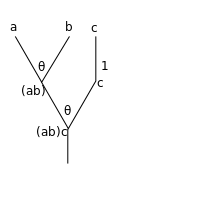
which yields a 3-ary operation:

However, the expression is a priori ambiguous: it could mean , if the inner compositions are performed first, or it could mean , if the outer compositions are performed first (operations are read from right to left). Writing , this is versus . That is, the tree is missing "vertical parentheses":
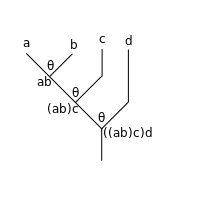
If the top two rows of operations are composed first (puts an upward parenthesis at the line; does the inner composition first), the following results:

which then evaluates unambiguously to yield a 4-ary operation. As an annotated expression:
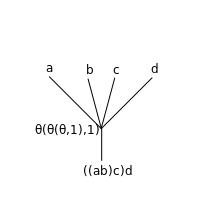
If the bottom two rows of operations are composed first (puts a downward parenthesis at the line; does the outer composition first), following results:

which then evaluates unambiguously to yield a 4-ary operation:

The operad axiom of associativity is that these yield the same result, and thus that the expression is unambiguous.
Identity axiom
The identity axiom (for a binary operation) can be visualized in a tree as:
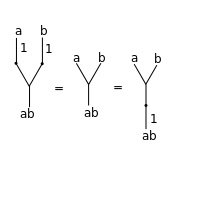
meaning that the three operations obtained are equal: pre- or post- composing with the identity makes no difference. As for categories, is a corollary of the identity axiom.
Examples
Endomorphism operad
Let V be a finite-dimensional vector space over a field k. Then the endomorphism operad of V consists of[10]
- = the space of linear maps ,
- (composition) ,
- (identity)
- (symmetric group action)
If is another operad, each operad morphism is called an operad algebra (notice this is analogous to the fact that each R-module structure on an abelian group M amounts to a ring homomorphism .)
Depending on applications, variations of the above are possible: for example, in algebraic topology, instead of vector spaces and tensor products between them, one uses (reasonable) topological spaces and cartesian products between them.
"Little something" operads


A little disks operad or, little balls operad or, more specifically, the little n-disks operad is a topological operad defined in terms of configurations of disjoint n-dimensional disks inside a unit n-disk centered in the origin of Rn. The operadic composition for little 2-disks is illustrated in the figure.[11]
Originally the little n-cubes operad or the little intervals operad (initially called little n-cubes PROPs) was defined by Michael Boardman and Rainer Vogt in a similar way, in terms of configurations of disjoint axis-aligned n-dimensional hypercubes (n-dimensional intervals) inside the unit hypercube.[12] Later it was generalized by May[13] to little convex bodies operad, and "little disks" is a case of "folklore" derived from the "little convex bodies".[14]
Swiss-cheese operad
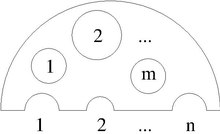
The Swiss-cheese operad is a two-colored topological operad defined in terms of configurations of disjoint n-dimensional disks inside a unit n-semidisk and n-dimensional semidisks, centered at the base of the semidisk and sitting inside the unit semidisk. The operadic composition comes from gluing configurations of "little" disks inside the unit disk into the "little" disks in another unit semidisk and configurations of "little" disks and semidisks inside the unit semidisk into the other unit semidisk.
The Swiss-cheese operad was defined by Alexander A. Voronov.[15] It was used by Maxim Kontsevich to formulate a Swiss-cheese version of Deligne's conjecture on Hochschild cohomology.[16] Kontsevich's conjecture was proven partly by Po Hu, Igor Kriz, and Alexander A. Voronov[17] and then fully by Justin Thomas.[18]
Associative operad
Another class of examples of operads are those capturing the structures of algebraic structures, such as associative algebras, commutative algebras and Lie algebras. Each of these can be exhibited as a finitely presented operad, in each of these three generated by binary operations.
Thus, the associative operad is generated by a binary operation , subject to the condition that
This condition does correspond to associativity of the binary operation ; writing multiplicatively, the above condition is . This associativity of the operation should not be confused with associativity of composition; see the axiom of associativity, above.
This operad is terminal in the category of non-symmetric operads, as it has exactly one n-ary operation for each n, corresponding to the unambiguous product of n terms: . For this reason, it is sometimes written as 1 by category theorists (by analogy with the one-point set, which is terminal in the category of sets).
Terminal symmetric operad
The terminal symmetric operad is the operad whose algebras are commutative monoids, which also has one n-ary operation for each n, with each acting trivially; this triviality corresponds to commutativity, and whose n-ary operation is the unambiguous product of n-terms, where order does not matter:
for any permutation .
Operads from the symmetric and braid groups
There is an operad for which each is given by the symmetric group . The composite permutes its inputs in blocks according to , and within blocks according to the appropriate . Similarly, there is a non- operad for which each is given by the Artin braid group . Moreover, this non- operad has the structure of a braided operad, which generalizes the notion of an operad from symmetric to braid groups.
Linear algebra
In linear algebra, vector spaces can be considered to be algebras over the operad (the infinite direct sum, so only finitely many terms are non-zero; this corresponds to only taking finite sums), which parametrizes linear combinations: the vector for instance corresponds to the linear combination
Similarly, affine combinations, conical combinations, and convex combinations can be considered to correspond to the sub-operads where the terms sum to 1, the terms are all non-negative, or both, respectively. Graphically, these are the infinite affine hyperplane, the infinite hyper-octant, and the infinite simplex. This formalizes what is meant by being or the standard simplex being model spaces, and such observations as that every bounded convex polytope is the image of a simplex. Here suboperads correspond to more restricted operations and thus more general theories.
This point of view formalizes the notion that linear combinations are the most general sort of operation on a vector space – saying that a vector space is an algebra over the operad of linear combinations is precisely the statement that all possible algebraic operations in a vector space are linear combinations. The basic operations of vector addition and scalar multiplication are a generating set for the operad of all linear combinations, while the linear combinations operad canonically encodes all possible operations on a vector space.
Commutative-ring operad
The commutative-ring operad is an operad whose algebras are commutative rings (perhaps over some base field). The Koszul-dual of it is the Lie operad and conversely.
Constructs
Typical algebraic constructions (e.g., free algebra construction) can be extended to operads. Let C denote a module category used in the definition of an operad; e.g., it can be the category of -modules for symmetric operads.
Free operad
There is the forgetful functor . The free operad functor is defined as a left adjoint to the forgetful functor (this is the usual definition of free functor). Like a group or a ring, the free construction allows to express an operad in terms of generators and relations. By a free representation of an operad , we mean writing as a quotient of a free operad generated by a module E: then E is the generator of and kernel of is the relation.
A (symmetric) operad is called quadratic if it has a free presentation such that is the generator and the relation is contained in .[19]
Operads in homotopy theory
In Stasheff (2004), Stasheff writes:
- Operads are particularly important and useful in categories with a good notion of "homotopy", where they play a key role in organizing hierarchies of higher homotopies.
See also
- PRO (category theory)
- Algebra over an operad
- Higher-order operad
- E∞-operad
- Pseudoalgebra
- Multicategory
Notes
- ”finiteness" refers to the fact that only a finite number of inputs are allowed in the definition of an operad. For example, the condition is satisfied if one can write
- ,
- .
Citations
- Boardman, J. M.; Vogt, R. M. (1 November 1968). "Homotopy-everything $H$-spaces". Bulletin of the American Mathematical Society. 74 (6): 1117–1123. doi:10.1090/S0002-9904-1968-12070-1. ISSN 0002-9904.
- Boardman, J. M.; Vogt, R. M. (1973). Homotopy Invariant Algebraic Structures on Topological Spaces. Lecture Notes in Mathematics. 347. doi:10.1007/bfb0068547. ISBN 978-3-540-06479-4. ISSN 0075-8434.
- May, J. P. (1972). The Geometry of Iterated Loop Spaces. Lecture Notes in Mathematics. 271. CiteSeerX 10.1.1.146.3172. doi:10.1007/bfb0067491. ISBN 978-3-540-05904-2. ISSN 0075-8434.
- May, J. Peter. "Operads, Algebras, and Modules" (PDF). math.uchicago.edu. p. 2. Retrieved 28 September 2018.
- Ginzburg, Victor; Kapranov, Mikhail (1994). "Koszul duality for operads". Duke Mathematical Journal. 76 (1): 203–272. doi:10.1215/S0012-7094-94-07608-4. ISSN 0012-7094. MR 1301191. Zbl 0855.18006 – via Project Euclid.
- Loday, Jean-Louis (1996). "La renaissance des opérades". www.numdam.org. Séminaire Nicolas Bourbaki. MR 1423619. Zbl 0866.18007. Retrieved 27 September 2018.
- Kontsevich, Maxim; Soibelman, Yan (26 January 2000). "Deformations of algebras over operads and Deligne's conjecture". arXiv:math/0001151.
- Jones, J. D. S.; Getzler, Ezra (8 March 1994). "Operads, homotopy algebra and iterated integrals for double loop spaces". arXiv:hep-th/9403055.
- N. Durov, New approach to Arakelov geometry, University of Bonn, PhD thesis, 2007; arXiv:0704.2030.
- Markl, Example 2
- Giovanni Giachetta, Luigi Mangiarotti, Gennadi Sardanashvily (2005) Geometric and Algebraic Topological Methods in Quantum Mechanics, ISBN 981-256-129-3, pp. 474,475
- Greenlees, J. P. C. (2002). Axiomatic, Enriched and Motivic Homotopy Theory. Proceedings of the NATO Advanced Study Institute on Axiomatic, Enriched and Motivic Homotopy Theory. Cambridge, United Kingdom: Springer Science & Business Media. pp. 154–156. ISBN 978-1-4020-1834-3.
- May, J. P. (1977). "Infinite loop space theory". Bull. Amer. Math. Soc. 83 (4): 456–494. doi:10.1090/s0002-9904-1977-14318-8.
- Stasheff, Jim (1998). "Grafting Boardman's Cherry Trees to Quantum Field Theory". arXiv:math/9803156.
- Voronov, Alexander A. (1999). The Swiss-cheese operad. Contemporary Mathematics. Baltimore, Maryland, United States: AMS. pp. 365–373. ISBN 978-0-8218-7829-3.
- Kontsevich, Maxim (1999). "Operads and Motives in Deformation Quantization". Lett. Math. Phys. 48: 35–72. arXiv:math/9904055. doi:10.1023/A:1007555725247.
- Hu, Po; Kriz, Igor; Voronov, Alexander A. (2006). "On Kontsevich's Hochschild cohomology conjecture". Compos. Math. 142 (1): 143–168. doi:10.1112/S0010437X05001521.
- Thomas, Justin (2016). "Kontsevich's Swiss cheese conjecture". Geom. Topol. 20 (1): 1–48.
- Markl, Definition 37.
References
- Tom Leinster (2004). Higher Operads, Higher Categories. Cambridge University Press. arXiv:math/0305049. Bibcode:2004hohc.book.....L. ISBN 978-0-521-53215-0.
- Martin Markl, Steve Shnider, Jim Stasheff (2002). Operads in Algebra, Topology and Physics. American Mathematical Society. ISBN 978-0-8218-4362-8.CS1 maint: multiple names: authors list (link)
- Markl, Martin (June 2006). "Operads and PROPs". arXiv:math/0601129.
- Stasheff, Jim (June–July 2004). "What Is...an Operad?" (PDF). Notices of the American Mathematical Society. 51 (6): 630–631. Retrieved 17 January 2008.
- Loday, Jean-Louis; Vallette, Bruno (2012), Algebraic Operads (PDF), Grundlehren der Mathematischen Wissenschaften, 346, Berlin, New York: Springer-Verlag, ISBN 978-3-642-30361-6
- Zinbiel, Guillaume W. (2012), "Encyclopedia of types of algebras 2010", in Bai, Chengming; Guo, Li; Loday, Jean-Louis (eds.), Operads and universal algebra, Nankai Series in Pure, Applied Mathematics and Theoretical Physics, 9, pp. 217–298, arXiv:1101.0267, Bibcode:2011arXiv1101.0267Z, ISBN 9789814365116
- Fresse, Benoit (17 May 2017), Homotopy of Operads and Grothendieck-Teichmüller Groups, Mathematical Surveys and Monographs, American Mathematical Society, ISBN 978-1-4704-3480-9, MR 3643404, Zbl 1373.55014
- Miguel A. Mendéz (2015). Set Operads in Combinatorics and Computer Science. SpringerBriefs in Mathematics. ISBN 978-3-319-11712-6.
- Samuele Giraudo (2018). Nonsymmetric Operads in Combinatorics. Springer International Publishing. ISBN 978-3-030-02073-6.